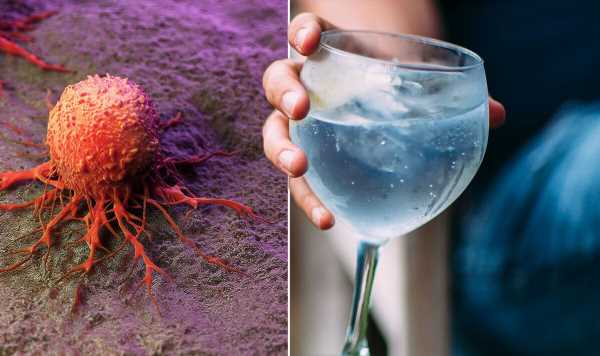Dr Dawn Harper on signs of vitamin B12 and vitamin D deficiency
We use your sign-up to provide content in ways you’ve consented to and to improve our understanding of you. This may include adverts from us and 3rd parties based on our understanding. You can unsubscribe at any time. More info
Despite the billions raised, invested and spent on cancer research, a cure for cancer has not been found. That speaks to the intractability of cancerous cells, which are hard to stop once they proliferate. However, the knowledge gained in the pursuit of finding a cure has been invaluable. We now have a much more sophisticated understanding of the causes and risk factors. One stone unturned is alcohol consumption.
According to Cancer Research UK, alcohol causes seven types of cancer, including breast, mouth and bowel cancer.
“All types of alcoholic drink can cause cancer,” warns the charity.
“Alcohol gets broken down into a harmful chemical and can also affect our body’s chemical signals, making cancer more likely to develop.”
Research into the causal mechanisms has also shed light on the destructive impact alcohol can have on DNA.

“Alcohol is broken down via a strict process and converted into energy. And it’s acetaldehyde, at the centre of this chain, that’s the weakest link,” explains Cancer Research UK.
“If acetaldehyde isn’t broken down further it builds up in cells, where it damages DNA in a way that could cause cancer.”
Professor Ketan Patel, and his team of Cancer Research UK-funded scientists at the MRC Laboratory of Molecular Biology in Cambridge, have now uncovered the kind of damage acetaldehyde causes to DNA – the blueprint of life that resides within cells.
And in doing so, they’ve shown the way cells prevent this damage and how the damage is fixed if it happens.
DON’T MISS
Non-alcoholic drink causes blood clot formation within ‘1 hour’ [ADVICE]
Diabetes: Vegetable found to lower blood sugar levels by 50% [TIPS]
B12 deficiency: The smelly symptom that signals low levels [INSIGHT]
Their work focuses on stem cells – a type of cell that supplies the many different specialised cells our bodies are made of.
It’s important to understand how the DNA code in stem cells is damaged, because this damage can give rise to different types of cancer.
Specifically, the team studied blood stem cells in mice, because as Professor Patel explained: “They’re a good way of monitoring changes and damage to DNA in a way that’s more informative than looking at cells in a dish.”
The team studied these stem cells to see if external factors such as alcohol can damage DNA in a way that can increase the risk of cancer.

Scientists already know cells can protect DNA from acetaldehyde by using a group of enzymes called acetaldehyde dehydrogenases (ALDH for short).
“When they’re working properly, the ALDH enzymes stop acetaldehyde building up by converting it into acetate, which cells can use as a source of energy,” said Professor Patel.
To see the damage acetaldehyde might cause to stem cells’ DNA, Professor Patel and his team had to look at cells that didn’t have these enzymes.
To do this, they used lab-based genetic engineering to create mice whose blood stem cells didn’t produce the enzyme ALDH2, meaning they couldn’t break down acetaldehyde.

They then gave these mice diluted ethanol, the purest form of alcohol, and used techniques to see the DNA inside the cells and read its code.
According to Professor Patel, the results were striking and remarkable.
They found that in bone marrow samples carrying blood cells lacking the ALDH2 enzyme, just one dose of ethanol caused a build-up of acetaldehyde that seriously damaged the DNA.
“We saw huge amounts of DNA damage in these cells. Bits of DNA were deleted, bits were broken and we even saw parts of chromosomes being moved about and rearranged,” the prof said.
How much alcohol is safe to drink?
To keep health risks from alcohol to a low level, both men and women are advised not to regularly drink more than 14 units a week.
A unit of alcohol is 8g or 10ml of pure alcohol, which is about:
- Half a pint of lower to normal-strength lager/beer/cider (ABV 3.6 percent)
- A single small shot measure (25ml) of spirits (25ml, ABV 40 percent).
Source: Read Full Article
